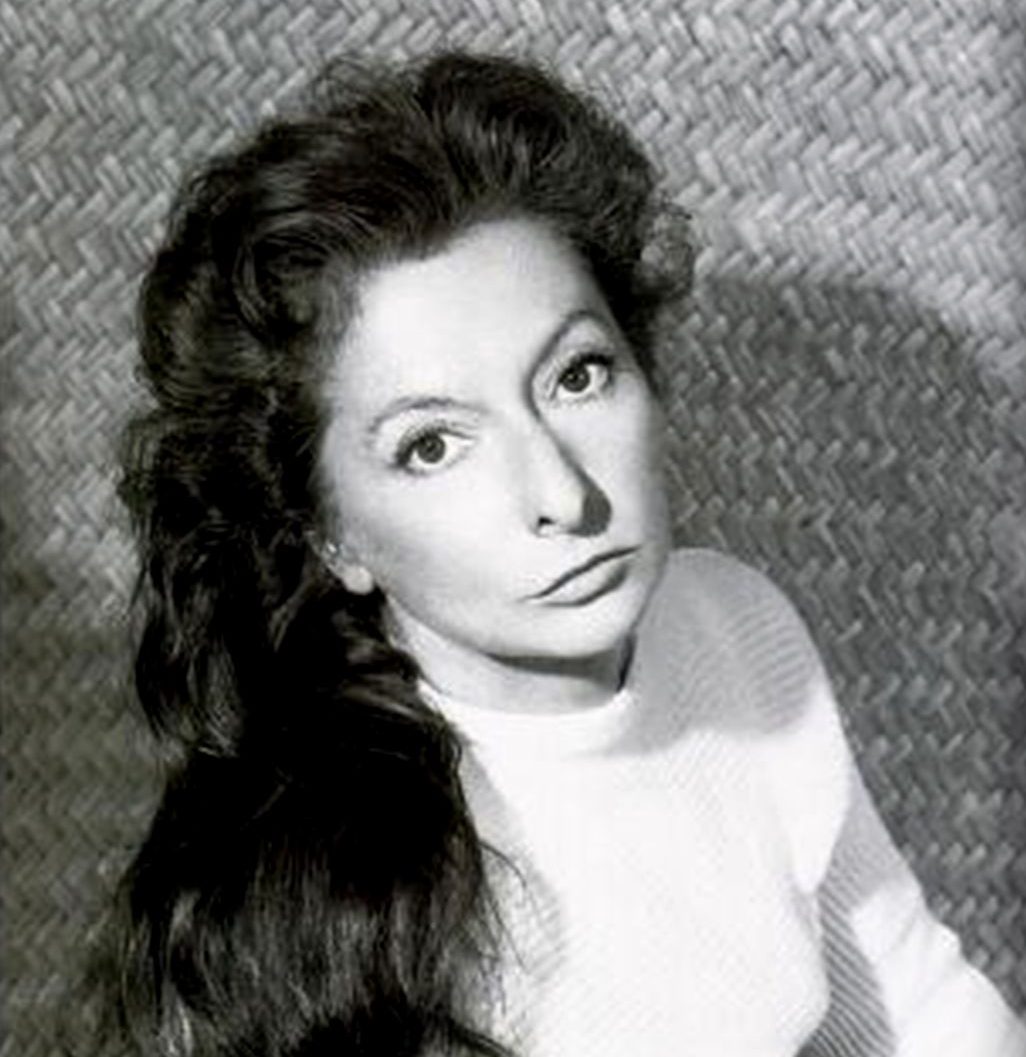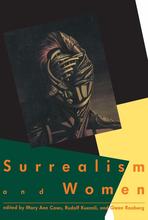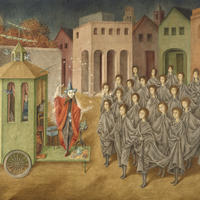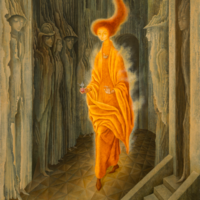More about Remedios Varo
- All
- Info
- Shop
Works by Remedios Varo

Sr. Contributor
Remedios Varo was born in Spain to a fanatical Catholic mother who named her after the Virgin of Los Remedios, and a bohemian father who encouraged creativity and independent thought.
Suffice it to say, Varo took after her father. Her idea of religious devotion was making regular visits to the Prado to lose herself in Hieronymus Bosch’s Garden of Earthly Delights.
Varo went to art school with Salvador Dali, and moved in a circle of surrealists who helped invent the artistic parlor game, exquisite corpse. With fascism rising and civil war boiling over in Spain, Varo briefly moved to Paris with her first husband, fellow artist Gerardo Lizarraga, and later returned to Paris long-term with her new lover, poet Benjamin Peret. Varo and Lizarrago never officially divorced (despite her later marrying Peret), and she even arranged for his release from a concentration camp when she recognized him by chance in a newsreel. As World War II erupted across Europe, Peret and Varo likewise found themselves imprisoned, him for refusing to enlist, and her for harboring him from the police. They got out of prison just as the Nazis were marching on Paris, and narrowly escaped to Casablanca.
Casablanca’s refugee society was a world of steamy glamor (famously portrayed in the 1942 Hollywood film), where Europe’s displaced cultural elite languished in colonial North Africa for transit papers to the Americas. Varo and Peret were among the lucky who procured passage across the Atlantic. Peret hoped to settle in the USA, but it turned out the “Land of the Free” was sucky to refugees back then too, so they went to Mexico.
Luckily, it was a good time to be an artist in Mexico. Varo renewed her friendship with Leonora Carrington, another emigre artist she had previously met in Paris. They also rubbed elbows with Diego Rivera and Frida Kahlo, but Frida wasn’t a big fan of the female expatriate painters, calling them, “those European b*tches.” Varo and Carrington, on the other hand, got along famously. They dramatically influenced each other’s work, but also got a kick out of throwing surrealist-inspired dinner parties where they would invite random strangers out of the phone book and serve them experimental cuisine such as human-hair omelettes and “caviar” of tapioca dyed with ink.
While this “homance” for the ages flowered, Varo’s love life was on-again, off-again. Peret, then her bigamous second husband, moved back to Paris following the war. She flitted around with pilot and adventurer Jean Nicolle for a while, joining him on a scientific expedition to Venezuela. She eventually settled down with Walter Gruen, a Buchenwald Holocaust survivor who tirelessly supported her art. She had primarily done commercial work prior to their relationship, and Gruen’s support allowed her to pursue her true calling full time. Just as she was starting to pick up steam in the ‘50s and early ‘60s, she died of a heart attack at age 54.
Varo died without a will, and Gruen bought 39 of her works on the open market and donated them to the Museum of Modern Art Mexico. Enter Varo’s estranged niece, Beatriz. Beatriz barely knew her aunt, and never expressed the slightest interest in the paintings until they started selling for a crapload of money. Nevertheless, she claimed she was the rightful owner as Varo’s closest living relative; so Beatriz, Gruen and the Museum went to court.
Gruen claimed to be Varo’s rightful heir as her common-law husband of 11 years. Since Varo never technically divorced her first husband, her subsequent partners were illegitimate. Despite spotty paperwork on the sales, Gruen produced a credible witness testifying that he had, in fact, bought the paintings legally. However, Beatriz maintained that he had no right to buy them in the first place, since they should have passed directly to her. A judge initially ruled in Beatriz’ favor, sparking universal outrage, but ultimately the paintings went back to the Museum.
Thanks to Gruen’s hard-fought efforts to solidify her legacy, Mexico has since acknowledged Varo’s cultural significance, though native-born artists maligned her as a colonialist outsider during her lifetime. The rest of the Western World is also starting catch on to her genius, due in part to master appropriator Madonna, who referenced Varo and Leonora Carrington in her 1995 music video, Bedtime Story.
Sources
- Benjamin Peret: Las parole est a Peret, New York 1943. Paris: Les Ameriques et autres lieux, 1992.
- Cate-Arries, Francie. Spanish Culture Behind Barbed Wire: Memory and Representation of the French Concentration Camps, 1939-1945. Cranbury, NJ: Lewisburg Bucknell University Press, 2004.
- Gallery Wendi Norris. “Remedios Varo.” accessed May 2, 2017. http://www.gallerywendinorris.com/remedios-varo/
- “In Court, Life Imitates Surrealist Art.” Banderas News, September 2005. http://www.banderasnews.com/0509/art-varo.htm
- Kaplan, Janet A. “Remedios Varo: Voyages and Visions.” Woman’s Art Journal 1.
- Kraul, Chris. “A legal battle that is Surreal.” Los Angeles Times, May 18, 2005. http://articles.latimes.com/2005/may/18/entertainment/et-mexart18

Contributor
Remedios Varo was an expert forger, stunning multitasker, and terrifying host.
Remedios Varo, jack of all trades and badass Spanish Surrealist, had seen conventionality and was not impressed. Daughter of an engineer with a Catholic school education, Varo would grow into a Surrealist powerhouse with an artistic posse even Andy Warhol would envy. Madonna herself wanted in on Varo’s star quality, using imagery from her work in her music video for “Bedtime Story.” Who could blame her?
The Spanish Civil War trapped Varo in Paris as a refugee, and the rise of Nazism finally forced her to flee to Mexico after a brief arrest. There, Varo worked with artists like Leonora Carrington, forming a tightknit group Frida Kahlo so eloquently called “those European b*tches.” Although she was quite introverted, Varo hosted far more sophisticated dinner parties than any of us. The cheeky surrealist took prank calls to new heights and asked arbitrary telephone book contacts to dine. Attendance was not advisable: the meals Varo concocted for her long-suffering friends were more science experiment than sustenance, culminating in a bone-chilling hair omelet. Also notable was Varo’s “caviar” constructed of tapioca, a less offensive but no less befuddling choice of ingredients.
Varo demonstrated her vast array of talents through the odd jobs she took on to make ends meet. Unfortunately, her resume made all other mere mortals seem woefully inadequate. While some of us have trouble tying shoelaces and adequately peeling an orange, Varo casually became a toymaker, medical illustrator, costume designer, and pottery mender. Not one to miss out on a good deal, Varo even forged works by Giorgio de Chirico.
Years after Varo’s death at 54, thirty-nine of her works in the Mexico City Museum of Modern Art became the subjects of a lengthy court battle. Contestants were Walter Gruen, Varo’s partner in life and a fellow refugee, the Mexican government, and Varo’s niece. Gruen had purchased the paintings and gifted them to the museum, unable to claim ownership as Varo never divorced her former husband. However, Varo’s niece claimed them as her right, arguing that Gruen couldn’t prove ownership. The result? A fight over art worth a whopping $15 million. It’s no surprise Varo’s paintings have increased in value-- anyone would want a piece made by Surrealism royalty.
Sources
- Blumberg, Naomi. "Remedios Varo." Encyclopedia Britannica. Accessed May 22, 2017. https://www.britannica.com/biography/Remedios-Varo.
- Fernandes, Andréa. "A Spanish Parisian in Mexico: Remedios Varo." Mental Floss. June 19, 2009. Accessed May 22, 2017. http://mentalfloss.com/article/22027/spanish-parisian-mexico-remedios-v….
- Kraul, Chris. "A Legal Battle that is Surreal." Los Angeles Times. May 18, 2005. Accessed May 22, 2017. http://articles.latimes.com/2005/may/18/entertainment/et-mexart18.
- Moorhead, Joanna. “The Surrealist Muses who Roared.” The Guardian. June 18, 2010. Accessed May 23, 2017. https://www.theguardian.com/lifeandstyle/2010/jun/18/surrealist-muses-w….
- Otero, Estrella de Diego. "Remedios Varo, la moderna visionaria." El País. January 27, 2016. Accessed May 22, 2017. http://elpais.com/elpais/2016/01/25/eps/1453724279_168385.html.
- "Remedios Varo." National Museum of Women in the Arts. Accessed May 22, 2017. https://nmwa.org/explore/artist-profiles/remedios-varo.
Featured Content
Here is what Wikipedia says about Remedios Varo
María de los Remedios Alicia Rodriga Varo y Uranga (known as Remei or Remedios Varo, 16 December 1908 – 8 October 1963) was a Catalan surrealist painter who lived in several European cities before being exiled in Mexico.
Check out the full Wikipedia article about Remedios Varo













